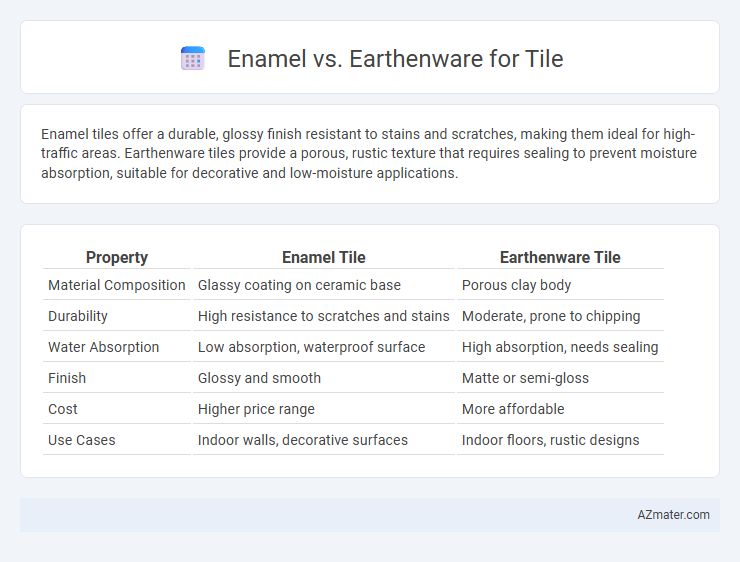Enamel tiles offer a durable, glossy finish resistant to stains and scratches, making them ideal for high-traffic areas. Earthenware tiles provide a porous, rustic texture that requires sealing to prevent moisture absorption, suitable for decorative and low-moisture applications.
Table of Comparison
| Property | Enamel Tile | Earthenware Tile |
|---|---|---|
| Material Composition | Glassy coating on ceramic base | Porous clay body |
| Durability | High resistance to scratches and stains | Moderate, prone to chipping |
| Water Absorption | Low absorption, waterproof surface | High absorption, needs sealing |
| Finish | Glossy and smooth | Matte or semi-gloss |
| Cost | Higher price range | More affordable |
| Use Cases | Indoor walls, decorative surfaces | Indoor floors, rustic designs |
Introduction to Tile Materials: Enamel vs. Earthenware
Enamel tiles feature a glassy coating fused to a ceramic base, offering durability, vibrant colors, and resistance to stains and moisture. Earthenware tiles are made from porous clay fired at lower temperatures, resulting in a softer, more absorbent material often glazed to enhance water resistance. Choosing between enamel and earthenware tiles depends on the desired balance of aesthetics, durability, and suitability for indoor or outdoor environments.
Composition and Manufacturing Differences
Enamel tiles feature a glassy coating fused onto a ceramic base through high-temperature firing, creating a smooth, durable surface resistant to moisture and stains. Earthenware tiles are made from natural clay fired at lower temperatures, resulting in a porous, softer material that requires sealing to prevent water absorption. The manufacturing distinction lies in enamel tiles using a vitrified coating process, while earthenware relies on traditional clay molding and lower heat treatment.
Surface Finish and Visual Appeal
Enamel tiles feature a glossy, smooth surface finish achieved through a glassy coating that enhances durability and offers vibrant, reflective colors ideal for modern and high-traffic spaces. Earthenware tiles possess a matte or slightly textured surface, with a warm, rustic aesthetic due to their porous, natural clay composition that absorbs stains more easily but provides a handcrafted, traditional look. The choice between enamel and earthenware tiles hinges on whether a sleek, polished appearance or a tactile, artisanal charm is prioritized for the design.
Durability and Wear Resistance
Enamel tiles offer superior durability and wear resistance due to their hard, glass-like surface that resists scratches, stains, and moisture, making them ideal for high-traffic areas. Earthenware tiles, although aesthetically warm and rustic, tend to be softer and more porous, requiring sealing and regular maintenance to prevent chipping and wear over time. The enhanced hardness and low porosity of enamel tiles ensure longer-lasting performance in both commercial and residential applications.
Water Absorption and Moisture Protection
Enamel tiles offer superior moisture protection with a glazed surface that drastically reduces water absorption, making them ideal for wet environments. Earthenware tiles, being porous and unglazed or lightly glazed, exhibit higher water absorption rates, which can lead to moisture damage over time. Choosing enamel over earthenware significantly enhances durability and prevents water-related deterioration in tiling applications.
Maintenance and Cleaning Requirements
Enamel tiles feature a smooth, non-porous surface that resists stains, making maintenance straightforward with regular wiping using mild soap and water. Earthenware tiles, being porous, require sealing to prevent water absorption and stains, necessitating more frequent cleaning and occasional resealing to maintain their appearance. Proper care for earthenware includes avoiding harsh chemicals to protect the glaze, while enamel tiles tolerate a wider range of cleaning agents without damage.
Applications: Best Uses for Each Type
Enamel tiles excel in high-moisture areas such as bathrooms and kitchen backsplashes due to their water-resistant and easy-to-clean surfaces. Earthenware tiles are ideal for low-traffic interior spaces like living rooms and decorative wall accents, where their porous nature and rustic appearance add warmth and character. Choosing enamel tiles enhances durability and hygiene, while earthenware tiles provide aesthetic charm in less demanding environments.
Cost Comparison: Enamel vs. Earthenware Tiles
Enamel tiles generally cost more than earthenware tiles due to their durable glassy coating and enhanced aesthetic appeal. Earthenware tiles, made from clay and fired at lower temperatures, tend to be more affordable but less resistant to wear and moisture. Budget-conscious projects often favor earthenware, while enamel offers long-term value through longevity and low maintenance.
Environmental Impact and Sustainability
Enamel tiles typically involve high energy consumption and synthetic chemicals during manufacturing, resulting in a larger carbon footprint compared to earthenware tiles. Earthenware is made from natural clay fired at lower temperatures, reducing energy use and promoting biodegradability, which enhances its sustainability profile. Choosing earthenware over enamel tiles significantly lowers environmental impact due to its renewable material source and reduced emissions in production.
Choosing the Right Tile for Your Project
Enamel tiles feature a glass-like coating that offers superior durability, stain resistance, and vibrant color retention, making them ideal for high-traffic or moisture-prone areas like kitchens and bathrooms. Earthenware tiles, made from porous clay fired at lower temperatures, provide a warm, rustic aesthetic but require sealing to prevent water absorption and staining, suitable for low-moisture indoor spaces. When choosing the right tile, consider Enamel for strength and easy maintenance, while Earthenware works best where natural texture and affordability are prioritized.

Infographic: Enamel vs Earthenware for Tile
 azmater.com
azmater.com